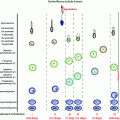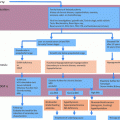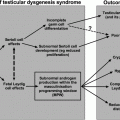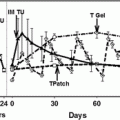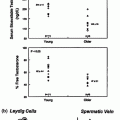Sex chromosomes
Responsible cell division
X-linked loci
Frequency (%)
XMXPY
Paternal meiosis
Identical to father
53
XM1XM2Y
Maternal meiosis I
Identical to mother
34
XM1XM1Y
Maternal meiosis II
Single maternal chromosome with heterozygosity in distal loci
9
XM1XM1Y
Mitotic (post-zygotic)
Single homozygous maternal chromosome
3
In an individual with KS, the extra X chromosome forms a dense chromatin mass, or “Barr body” within the nuclei of somatic cells, but exactly how the presence of this extra chromosome leads to testicular failure remains a mystery. Microarray analysis reveals over- and underexpression of various genes on the X chromosome and autosomes that presumably contribute to the features of KS [12]. Testicular biopsy specimens from infants with KS may reveal only a reduced number of germ cells [13]. After puberty, fibrosis of the seminiferous tubules begins, eventually leading to small, firm testes and azoospermia [4]. Testicular biopsy specimens from adults with KS reveal marked seminiferous tubule hyalinization with focal areas of immature seminiferous tubule formation and fibrosis with a resulting increase in the amount of interstitium (Fig. 9.1). An absence of functional Sertoli cells in the seminiferous tubules is accompanied by low-level inhibin B in serum [5], the hormone whose existence Klinefelter and colleagues had hypothesized in their original paper.
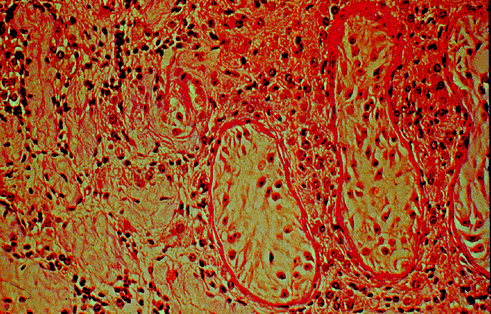

Fig. 9.1
Testicular biopsy specimens an individual with KS. Note focal areas of immature seminiferous tubules interspersed with completely hyalinized tubules and an increase in interstitial tissues (photograph courtesy of Dr. C. Alvin Paulsen)
The hormonal axis in boys with KS can appear normal until puberty, with no apparent differences in levels of testosterone (T), luteinizing hormone (LH) or follicle-stimulating hormone (FSH) compared to controls [14–16]. In addition, gonadotropin production in response to GnRH stimulation is normal. However, at the time of puberty, elevated basal FSH and LH levels and an exaggerated FSH and LH response to GnRH stimulation, and low or low-normal testosterone levels are seen, presaging the hormonal abnormalities seen in adults with KS. Testosterone production in a man with KS declines with aging in a fashion similar to controls [17, 18].
The cause of the language difficulties often encountered by individuals with KS is not well understood; however, high-resolution MRI scans of the brains of a small number of men with KS have demonstrated a relative reduction in left temporal lobe gray matter compared with control subjects [19]. Interestingly, individuals with KS who had been treated with testosterone had larger left temporal lobe volumes than individuals with KS who had not received testosterone therapy. Moreover, verbal fluency scores were significantly improved in the KS-testosterone groups as compared with the KS-no testosterone group, demonstrating that relatively low levels of testosterone during development may play a major role in the verbal and language problems related to KS.
The pathophysiology of KS-related gynecomastia is also unclear. Individuals with KS do exhibit mildly elevated levels of estradiol, probably from increases in peripheral aromatization and decreased clearance. However, histologic analysis of breast tissue from individuals with KS demonstrates intraductal hyperplasia rather than the ductal hyperplasia seen in high estrogen states in the male such as cirrhosis [20].
Clinical Features of Klinefelter Syndrome
The major clinical manifestations of KS are those of pre-pubertal androgen deficiency and infertility. Because testicular failure occurs before puberty, some of the normal developmental changes in puberty do not occur. This leads to the classic phenotype of KS: long legs, with an arm span frequently greater than height, gynecomastia, decreased muscle mass and increased abdominal adiposity, decreased facial and body hair, and small testes–which often measure less than 5 cc in volume. Long legs may be partly due to overexpression of the short stature homeobox (SHOX) gene on the X chromosome [21]. The penis may be decreased in size but is often of normal length. Gynecomastia is variable, but is often prominent and may require surgical correction. Mosaicism may present more subtly, as affected individuals can appear anywhere along a phenotypic spectrum between classical KS and “normal.” Infertility is almost universal; however, children have been fathered by men mosaic for KS [22] and via assisted reproductive techniques (see below). The frequency of various symptoms and signs of KS is summarized in Table 9.2.
Table 9.2
Clinical and physical characteristics of men with Klinefelter syndrome
Feature | Percent |
|---|---|
Infertility | 99–100 |
Small testes | 99–100 |
Gynecomastia | 50–75 |
Decreased facial and pubic hair | 50–80 |
Decreased penis size | 10–25 |
Hormonally, roughly one-half of affected men have decreased total testosterone levels, almost all have elevated gonadotropins, particularly FSH, but estradiol levels are usually fairly normal (Table 9.3) [18]. More than 90% of men have increased levels of serum gonadotropins, particularly FSH, as inhibin B levels are very low [5]. Because of low levels of androgens, individuals with KS can have low bone mineral density and are at increased risk of osteoporosis, even despite seemingly adequate androgen therapy [23]. This is likely due to failure to achieve peak bone mass early in life, as testosterone replacement before the age of 20 can improve bone mass to normal levels, whereas testosterone therapy started later in life is less effective [24]. As a result, calcium and vitamin D supplementation as well as baseline densitometry are probably prudent in individuals with KS, especially those who began androgen therapy later in life.
Table 9.3
Serum hormones in men with Klinefelter Syndrome
Hormone | Mean ± SD | Reference range | % Abnormal |
|---|---|---|---|
Testosterone (ng/mL) | 2.7 ± 1.6 | 2.8–8.8 | 45 |
FSH (IU/L) | 35.4 ± 16.2 | 1–8 | 100 |
LH (IU/L) | 22.3 ± 11.6 | 2–12 | 83 |
Estradiol (pg/mL) | 26.5 ± 13.2 | 18–44 | 6 |
Prolactin (ng/mL) | 16.5 ± 11.3 | 5–20 | 33 |
At one time, individuals with KS were thought to be frequently retarded and/or at increased risk of criminal behavior [25, 26]. These studies were based on pre-selected (usually committed or incarcerated) populations, however, and were not representative of the syndrome as a whole. Subsequent population-based studies have demonstrated a non-significant, but slightly increased rate of incarceration among individuals with KS. This increased rate of imprisonment is most likely accounted for by lower average scores on IQ tests compared with controls [27].
Individuals with KS can exhibit significant deficits in language processing skills including: reading and spelling, verbal processing speed, verbal and non-verbal executive abilities and motor dexterity [28, 29]. In general, this leads to lower average school performance and an increased frequency of psychological consultation. In addition, adolescent males with KS exhibit lowered sexual activity compared with their peers [30]. Expression of genes on the supernumerary X chromosome in the central nervous system may contribute to these behaviors [31]. It is important to remember that individual variation in mental function is marked, and some individuals with KS perform well above average on intelligence tests. Moreover, it seems likely that early developmental interventions and language tutoring in boys can assist in preventing disabling difficulties with language skills later in adult life [25, 32].
Morbidity Associated with Klinefelter Syndrome
Data from large population-based studies of chromosome abnormalities at birth have demonstrated that the KS occurs in about 1 in 400–600 male births [33–35]. However, only 25% of men with KS appear to receive a diagnosis [32], suggesting that many men with KS do not receive appropriate medical care. The failure to diagnose most men with KS, could likely be addressed by routine testicular examination in clinical settings, as the testes of most men with KS are much smaller than normal (usually less than 5 cc in KS vs. greater than 15 cc in normal men). However, testicular examinations are frequently not performed by clinicians seeing young men for reasons other than infertility or testicular discomfort. Alternatively, greater awareness of KS in the general population could improve rates of diagnosis.
In adults, overall age-matched mortality appears to be roughly doubled [36, 37]. Most of this increase is from non-neoplastic diseases of the cardiovascular, respiratory and digestive systems, and diabetes; however, the incidence of breast cancer and autoimmune disease is somewhat increased [38, 39].
In particular, the risk of breast cancer is 20-fold higher in men with KS, who account for 4% of all breast cancer cases in men. Fortunately, breast cancer in men is rare, so the absolute risk of breast cancer in a given man with KS is well under 1%. As a result, screening mammography is not generally recommended [40]. Men with KS also have an increased risk of extra-gonadal germ cell tumors [41]. Such patients are young and frequently present with advanced disease, often of the mediastinum. It is thought that these neoplasms arise from primordial germ cells that failed to complete migration to the fetal testes during embryogenesis. These germ cell precursors may then undergo malignant transformation partly in response to the elevated gonadotropin levels seen in individuals with KS. Fortunately, these tumors are rare even in individuals with KS, and most of these tumors respond well to chemotherapy.
There may be an increased risk of autoimmune disease in individuals with KS. Systemic lupus erythematosus, rheumatoid arthritis, ankylosing spondylitis and even rare forms of vasculitis such as Takaysu’s arteritis have been reported in KS patients, although the true relative increase in risk is difficult to calculate due to the small number of individuals affected [42–44]. It has been speculated that this possible increased risk of autoimmune disease is due to an increase in the estrogen to testosterone ratio, as it is believed that elevated levels of circulating estrogen may place premenopausal women at increased risk of autoimmune disease [45]. Alternative explanations for this increased risk of autoimmune disease in individuals with KS include abnormalities in “regulatory” T-lymphocyte subsets, as is observed in women with autoimmune disease. It is interesting to note that androgen therapy has been observed to improve clinical symptoms of autoimmune disease as well as correcting some of the laboratory features of autoimmunity [46].
Diabetes mellitus, usually type 2, is more common in individuals with KS than in the general population [47, 48] and may be present even before puberty [49]. The mechanism of diabetes in men with KS is probably due to a post-receptor defect in insulin action [50].
In addition to diabetes, men with KS may be at increased risk of other elements of the metabolic syndrome [51], especially when KS occurs in combination with obesity [52, 53]. As a result, screening for hypertension and hyperlipidemia should occur early in men with KS for the purposes of preventing premature atherosclerosis [51].
Taurodontism (an enlargement of the pulp in molar teeth) is seen in almost half of men with KS [54]. Taurodontism is diagnosed by dental X-rays and predisposes to premature dental caries and tooth loss. Good dental hygiene and frequent cleaning may be protective.
Early varicose veins are a feature of KS with 20% of men having severe varicosities at a relatively early age [55]. In addition to lower-extremity venous ulcers and an increased risk of deep-vein thrombosis have been noted [56, 57]. There is speculation that a defect in venous basement membrane connective tissue is present in some individuals with KS.
Diagnosis of Klinefelter Syndrome
KS is unique in that it can be diagnosed at almost any age: in utero, in a pre-pubertal boy, in an adolescent or even an adult male presenting to either a general practice or to an infertility clinic. Chromosomal karyotyping on amniotic fluid obtained from amniocentesis for an abnormal triple-screen or for advanced maternal age will reveal KS with great accuracy. KS can be suggested in pre-pubertal children by a testicular size of less than 2 cm after the age of six years [58]. Additional clues to the diagnosis of KS in a pre-pubertal male are verbal learning disabilities or taurodontism. After puberty, men with KS will often exhibit tall stature (usually greater than 184 cm.) with disproportionally long legs and frequently manifest an arm span that is greater than their height [59]. In adults, the diagnosis of KS should be considered in men with gynecomastia, primary hypogonadism, infertility or osteoporosis. Since serum testosterone levels may be normal, serum gonadotropins should also be measured. Peripheral blood karyotyping can be used to confirm the diagnosis, although this test can be negative in mosaic individuals, and tissue karyotype may be necessary [9].
Treatment of Klinefelter Syndrome
Testosterone therapy results in a more “male” phenotype, with increases in facial and pubic hair, muscle size and strength, increased libido and bone mineral density and improved mood [24, 49, 60, 61]. Optimally, testosterone therapy is begun at puberty allowing boys with KS to experience pubertal changes in tandem with their peers. In addition, this allows for optimal enhancement of bone mineral density. Even if testosterone therapy is not initiated until adulthood, it is still associated with beneficial improvements in mood, behavior and sense of well-being [61]. Testosterone therapy has no beneficial impact on infertility or on gynecomastia, which requires surgical resection if bothersome.
Testosterone therapy is safely and easily accomplished by either periodic intramuscular injection of testosterone esters, or transdermal gels described in detail elsewhere in this volume. The replacement dose for intramuscular esters of testosterone is 200 mg IM every other week in adults. Adolescents are usually started at lower doses (e.g., 50–100 mg every 2–4 weeks) and are gradually increased to adult doses over 2–3 months [14]. Side effects of testosterone therapy include weight gain, mostly due to increases in lean body mass, and acne. In older men, erythrocytosis is seen with some frequency. Induction or a worsening of sleep apnea may occur [60]. In general, testosterone therapy is both beneficial and well tolerated by individuals with KS, most of whom continue therapy long term [62]. Twenty-year follow-up of cohorts of men with KS treated with testosterone have demonstrated marked improvements in mental health, working capacity social adjustment and inter-personal relationships that are similar to improvements seen in hypogonadal control cohorts [63]. As a result, most physicians feel that early recognition and treatment with testosterone therapy is of great benefit to the long-term health and welfare of men with KS.
Stay updated, free articles. Join our Telegram channel

Full access? Get Clinical Tree


